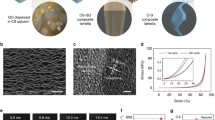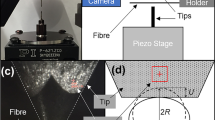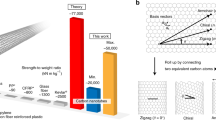Abstract
Carbon microballoons (CMBs) with tap densities of 0.143, 0.161, and 0.177 g/cm3, as measured per ASTM B 527-93, were characterized in terms of individual balloon diameter, wall thickness, and mechanical behavior in compression through a novel uniaxial compression test technique. This compression test, performed on an MTS Nanoindenter XP II, utilized a flat-ended cylindrical tip rather than the common Berkovich indenter. Quantitative microscopy techniques were used to obtain diameter and wall thickness measurements on the polished cross-sections of individual CMBs that had been cold mounted in epoxy resin. Though there was significant overlap in the three populations, a trend toward increasing average wall thickness—from 1.32 to 2.16 μm—with increasing tap density was observed. Compressive property data including failure load, failure strain, fracture energy, and stiffness were obtained for individual microballoons. Comparison of these data, both inter- and intra-tap density, has yielded some viable trends. CMB failure strain exhibited a dependence upon the inverse square root of the CMB diameter, and CMB failure load depended linearly upon CMB stiffness. Averages for each tap density’s failure load, pseudo-stiffness, and fracture energy were also calculated and observed to increase with tap density.
Similar content being viewed by others
References
K. OKUNO and R. R. WOODHAMS, Cell. Plast. (1973) 8.
H. S. KIM and H. H. OH, Applied Polymer Science 76(2000) 1324 5.
G. GLADYSZ and K. K. CHAWLA, in “Composite Foams, in Encyclopedia of Polymer Science & Technology” (John Wiley, New York, 2004) p. 267.
M. KOOPMAN, G. GOUADEC, K. CARLISLE, K. K. CHAWLA and G. GLADYSZ, Scripta Materialia 50 (2004) 593.
K. CARLISLE, K. K. CHAWLA, G. GOUADEC, M. KOOPMAN and G. M. GLADYSZ, in Nanocompressive properties of carbon microballoons and mechanical properties of carbon based syntactic foam composites. in ICCM-14 (San Diego, CA, 2003) Society of Manufacturing Engineers.
ASTM D 3102-78: Standard Practice for the Determination of Isostatic Collapse Strength of Hollow Glass Microspheres. American Society for Testing and Materials. (1984).
K. CARLISLE, K. K. CHAWLA, G. GLADYSZ and M. KOOPMAN, J. Mat. Sci. (2006) (this issue).
R. T. DEHOFF and F. N. RHINES (Eds.), in “Quantitative Microscopy” (McGraw-Hill, New York, 1968).
R. J. ROARK, in Roark’s Formulas for Stress and Strain edited by W. C. Young (New York: McGraw-Hill, 1989)p. 542.
G. M. GLADYSZ, B. PERRY, G. MCEACHEN and J. LULA, J. Mat. Sci. (2006) (This issue).
P. W. BRATT, J. P. CUNNION and B. D. SPIVAK, in Mechanical Testing of Glass Hollow Microspheres, in Advances in Materials Characterization edited by D. R. Rossington, R. A. Condrate and R. L. Snyder (New York, Plenum Press, 1983) p. 441.
Author information
Authors and Affiliations
Rights and permissions
About this article
Cite this article
Carlisle, K.B., Koopman, M., Chawla, K.K. et al. Microstructure and compressive properties of carbon microballoons. J Mater Sci 41, 3987–3997 (2006). https://doi.org/10.1007/s10853-006-7574-8
Published:
Issue Date:
DOI: https://doi.org/10.1007/s10853-006-7574-8




